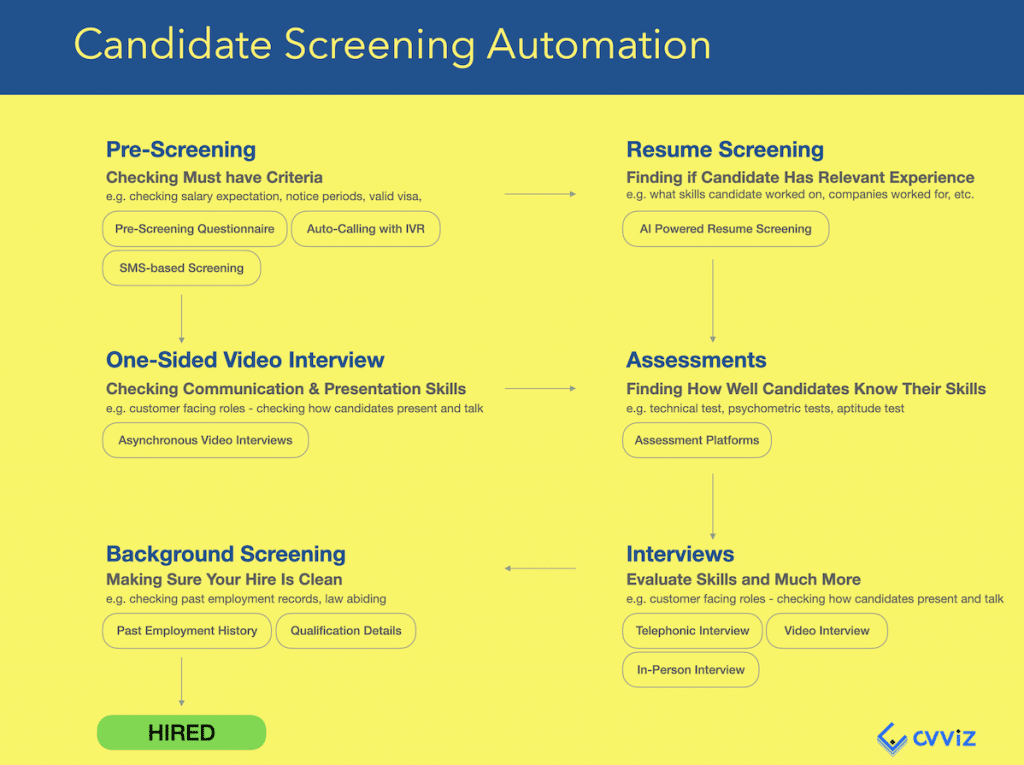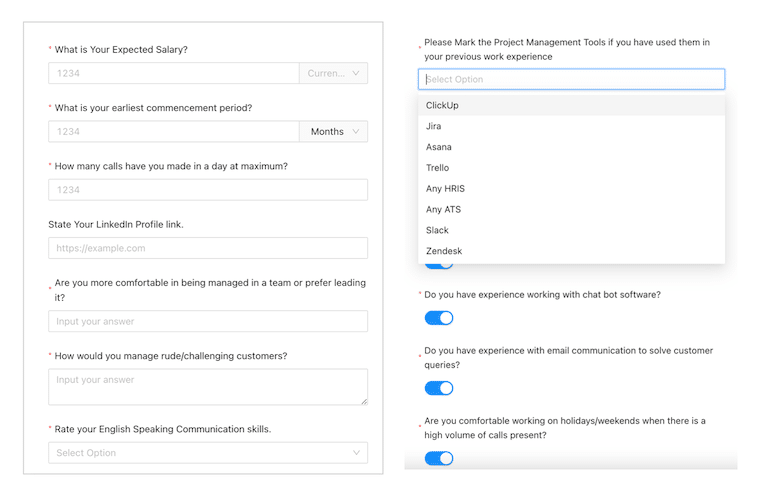Candidate screening is a way to assess the candidate at different stages of the hiring process.
There could be various stages in the candidate screening process, such as phone screening, tech or psychological screening, must-have criteria assessment, asynchronous video interviews or one-sided interviews, CV screening, face-to-face interviews, and background screening.
In the modern recruitment process, candidate screening happens in two phases –
- Before or at the time of job application
- After candidates apply for the job
Today, with the help of candidate screening tools, we can automate every stage of the candidate screening process.

Let us review different stages of the candidate screening process in recruitment and discuss how to automate candidate screening.
Pre Screen Candidate – Does Candidate Meet The Must Have Criteria?
Before considering a candidate for any position, you need to know some basic information about the candidate. Or there could be some must-have criteria for a job that a candidate needs to fulfill.
Must have criteria questions could be various.
For example, if the candidate is willing to work a shift or the salary expectation of the candidate.
What is the notice a candidate needs to serve? If a candidate has a valid visa, etc.
Only when the candidates meet the must-have criteria, you would push them to the next stage of recruitment.
Imagine, if you use an outbound sourcing approach, you will have to do a lot of cold calling to share job opportunities with various candidates.
And if the candidate is interested, you will need to ask some prescreening questions to confirm if they meet the must-have criteria.
However, calling so many candidates and asking them these questions is exhausting, challenging, and time-consuming at the same time.
It is not the best use of the recruiter’s time.
So, can we automate or simplify the phone screening?
Yes!
Here are the three ways you can automate the candidate prescreening process.
- Engaging candidates over SMS or text messaging for quickly screening them.
- Sending candidates a must-have questionnaire and storing their responses.
- Auto calling and using IVR (Interactive Voice Recording) system to record their answers.

Similarly, if you go with inbound candidate sourcing, you can embed prescreening questionnaire in the job application form.
Resume Screening – Match Right Candidates With The Right Opportunity
Once you filter the candidates that meet the must-have criteria, the next step is resume screening.
With resume screening, you want to discover if the candidate has the necessary qualifications and relevant work experience. You also want to know the various companies candidate worked for, etc.
However, resume screening is mostly about evaluating candidates on their work experience. You need to scan every resume to know if the candidate has the relevant experience. Therefore, resume screening is a time-consuming process.
When you have piles of resumes, you could take days or weeks to find the relevant candidates.
So, can you automate resume screening?
The answer is, Yes!
Using artificial intelligence, you can automate the resume screening process. Automating resume screening will help you screen thousands of resumes instantly. Here is a resume screening guide to help you understand it in more detail.
One-Sided Video Interviews – Get Facetime with the Candidate
When you hire for customer-facing roles, you need to check the candidate’s communication and presentation skills. When hiring for such job roles, having a recorded video response to a few key questions helps a great deal.
Hospitality is one such industry.
In a one-sided video interview, the questions pop up on the screen, and candidates have to video record their answers.
Combine the questionnaire with the one-sided video interview, and you have an effective solution for automated candidate screening!
One-sided interviews are also known as Asynchronous Video Interviews.
Assessments – How Well Candidates Know Their Skills
After resume screening, once you find the relevant candidates, you can use assessments to evaluate them for technical, psychometric, or aptitude skills.
Assessments often tell you the strong and the weak areas of the candidates.
Generally, assessment-based candidate screening is effective for campus recruitment, graduates hiring, or entry-level job hiring.
In other words, assessments are for high-volume hiring.
Conducting such assessments manually for a large group of candidates would be a nightmare.
There are platforms like iMocha, and Mettl available for automated assessments that not only automate the assessments but also come up with unique questions every time.
Also, these assessment platforms can easily integrate with modern recruiting software.
Interviewing The Candidate
The oldest and the most trusted way of screening is interviewing the candidate.
There are three ways in which the interviews could take place.
- Telephonic Interview
- Video Interview
- Face-to-face Interview
Telephonic Interview
Usually, companies start the interview process with a telephonic interview. The main aim of the telephonic interview is to assess the primary skills of the candidate that are important to perform the job.
There could be multiple rounds of interviews. The number could vary from company to company.
Once the candidate clears the telephonic interview, the candidate would get the call for the next round of interviews.
Video Interview
After the telephonic screening round comes a video interview. Sometimes, a video interview is also referred to as a virtual interview.
Video interview helps you know more about the candidate that is not only related to core skills.
You get to know how candidates present themselves. You can observe their body language, their communication, and more.
The pandemic situation has made video interviews even more popular.
At the same time, technology has pushed video interview screening to a different level altogether. A modern video interviewing tool can analyze the candidate’s expression, body language, tone, etc., and then gives the overall score.
If a candidate is not able to make it for a face-face meeting then a video interview could be a good substitute.
Face-to-face Interview
There cannot be any replacement for a face-to-face interview. Meeting someone in person tells so much more about that person.
You right away feel the vibe, the energy they carry.
Also, in-person interviews are cheating proof. There is a possibility that a candidate could cheat in telephonic or video interviews, but they can’t in a face-to-face interview.
Background Screening
The last step in a candidate selection process is offering the job to a candidate who would have come on top.
Before you onboard a candidate, making sure the candidate is clean is critical.
You want to ensure the candidate has no criminal records or has not violated the law.
You also want to verify the information candidates have provided about their qualifications and previous employment is valid.
The only way you can verify this is by running the background check on that candidate.
Background screening is a specialized job, and some agencies perform background verification for their clients. Some of these agencies are digital and offer APIs as well. The APIs can be integrated into your Applicant Tracking System.
Why Automate Candidate Screening Process?
As an organization, your goal is to hire the best candidates in the quickest time.
However, as we have discussed above, candidate screening is a multi-stage process. As we progress in the recruitment process, we have to screen many candidates at different stages.
When we screen candidates manually, it adds delay at each stage.
A slow and inefficient hiring process will affect the candidate’s experience. It could also mean losing top talent to your competition.
At the same time, doing manual, repetitive tasks could impact recruiters’ productivity.
You want your recruiters to spend time engaging the relevant candidates rather than spending time on mundane tasks.
The only way you can make job screening efficient for candidates and recruiters is by automating it.
By automating the candidate screening process you make sure that you identify the right candidates much early in the hiring process, improving the quality of hire and reducing the time to hire.




